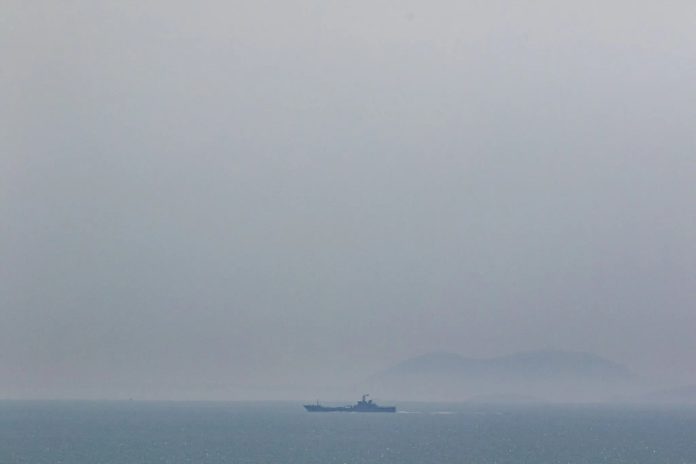China has been steadily intensifying military pressure on Taiwan over the past year, sending jets, drones, bombers and other planes farther and in greater numbers to extend an intimidating presence all around the island.
Chinese naval ships and air force planes have been edging closer to Taiwan’s territorial seas and skies, probing the island’s vigilance and trying to wear down its military planes and ships. Chinese forces have also been operating more frequently in skies and waters off the island’s eastern coast, facing the West Pacific. China’s increasing presence there signals its intent to dominate an expanse of sea that could be vital for the island’s defenses, including for securing potential aid from the United States in a conflict, experts say.
Beijing claims Taiwan is its lost territory that must accept unification, preferably peacefully, but by force if Chinese leaders deem that necessary. It has seized on moments of high tension with Taiwan to intensify military activities around the island, and it may put on another show of force in the coming days, when Taiwan’s vice president, Lai Ching-te, passes through the United States.
Mr. Lai leaves on Saturday for Paraguay, and is scheduled to stop in the United States on his way there and back. Beijing regards such transits in the United States as an affront to its stance that Taiwan is not an independent state. Mr. Lai is also the presidential candidate for the Democratic Progressive Party, which supports asserting Taiwan’s separate status, a position that Beijing condemns as “separatism.”
Nearly every day, the Chinese send sorties toward Taiwan that involve increasingly diverse and sophisticated arrays of planes. They now often cross the median line in the Taiwan Strait, effectively erasing what was until several years ago an informal boundary between the two sides. Such moves could narrow the time that Taiwan would have to react to a surprise escalation, said Chang Yan-ting, a retired deputy commander of Taiwan’s Air Force.
“China wants to seize air supremacy,” he said in an interview. “In the past, there was a buffer, our median line in the Taiwan Strait, and that gave enough warning time and strategic depth. Now that’s gone, disappeared.”
Taiwan’s defense ministry said on Thursday that it had detected 33 Chinese military aircraft near the island in the previous 24 hours, including 10 across the median line — an uptick compared to recent days.
The military exercises have increased notably since last August, when Nancy Pelosi, then the speaker of the House of Representatives, visited Taiwan. China responded with several days of live-fire drills, landing missiles in the waters to the north, south and east of Taiwan, and sending planes across the median line — exercises that some experts saw as honing Beijing’s ability to impose a blockade around the island.
The aircraft that China deploys around Taiwan now include planes for aerial refueling and helicopters for anti-submarine warfare, and large numbers of military drones, said Ou Si-fu, a researcher at the Institute for National Defense and Security Research, which is under Taiwan’s ministry of defense. That’s a sign of China’s growing efforts to project power far beyond its shores and conduct more sophisticated operations that integrate the air force with the navy, Mr. Ou said.
Since 2019, Chinese fighter jets, bombers, drones and other military aircraft have routinely entered Taiwan’s “air defense identification zone,” or ADIZ — a buffer area much wider than Taiwan’s territorial airspace where planes are supposed to identify themselves before entry and then obey instructions. (China’s planes do not.)
Last year, China made more than 1,700 flights into Taiwan’s air defense identification zone, nearly double the number in 2021, according to Ben Lewis, a military analyst who maintains a data set on the flights using daily reports from Taiwan’s ministry of defense. In the first half of this year, Taiwan recorded more than 850 flights by Chinese forces into the zone, 54 percent more than the number of flights for the same months of last year, he said. “Normalization of these activities is the goal,” he said.
The increase in flights does not mean that war is looming, and few in Taiwan believe that an invasion by China is imminent or inevitable. The People’s Liberation Army’s increase in activity around Taiwan is better understood as a longer-term effort to corrode its security and alertness, said experts.
“The first time they do something it’s ‘Oh, my god! Oh, my god!,’ but after they’ve done it five times, it’s ‘Oh, yeah, it’s routine, no big deal,’” said Kenneth W. Allen, a retired U.S. Air Force officer who researches the Chinese air force and its activities around Taiwan. “But the trends should be a big deal.”
Taiwan, with its much smaller military, seems to have no easy way of pushing back against the People’s Liberation Army’s aerial encroachment. A big buildup of fighter jets in Taiwan could be expensive and vulnerable to attack, and divert funds from buying mobile missiles and other weapons that may better deter Beijing.
To help Taiwan, the United States has sold more advanced fighter jets and other military hardware to the island’s government, though deliveries have lagged. Last month, the Biden administration announced $345 million in military aid for Taiwan and said the weapons would be drawn from the United States’ own reserves, which may help speed up deliveries.
But China’s numeric lead is daunting. It has about 1,900 combat-ready fighter jets, including advanced models, while Taiwan has about 300, quite a few of which are older, according to the Pentagon’s latest public assessment of the People’s Liberation Army. It said that China’s air force “is rapidly catching up to Western air forces.”
China’s leader, Xi Jinping, appears determined to maintain the pace of this expansion. Last month, he told a meeting of the Politburo, a council of 24 top Communist Party officials, that China’s military modernization goals had entered “a crucial period.” A recent documentary series on Chinese state television, “Chasing the Dream,” has portrayed Chinese troops as confident, but willing to die if necessary, in any war.
“If there is one day that would make me truly proud,” a pilot says in one episode, “I think it will be the moment when our motherland is unified.”
Responding to China’s ramped-up military activity places a considerable burden on Taiwan’s defense budget. In 2020, Taiwan spent nearly 9 percent of its defense budget on monitoring and tailing Chinese military planes and ships.
Taiwan has stopped routinely sending fighter jets to monitor the Chinese flights, and now does so only when the flights appear more threatening. Even so, in January, its defense ministry asked for additional funding of around $54 million to cover the expenses of coping with the Chinese flights.
Taiwan has “fairly robust” ground-based defense systems, such as radars and missiles, that could counter Chinese air intrusions and ballistic missiles, said J. Michael Cole, a security analyst in Taipei.
“It has sufficient capability to counter limited strikes,” said Mr. Cole, who is a senior adviser at the International Republican Institute. But, he added, “large-scale missile attacks or saturation attacks would likely overwhelm Taiwan’s air defense systems.”
Last month, Taiwan held annual exercises to demonstrate its readiness across air, land and sea. Lee Rong-teng, a lieutenant colonel in Taiwan’s army, monitored the drills at Taoyuan International Airport, where helicopters and about 180 soldiers took part in the drill to practice repelling an attempted takeover. But he sounded a note of warning.
If there were real fighting on the ground at the airport, he said, that could imply that Taiwan had already lost the war in the air. “By the time you’re using infantry forces, it will be, more or less, over,” he said. “Why? Because if the enemy arrives, we’ll have already lost sea and air superiority.”









































